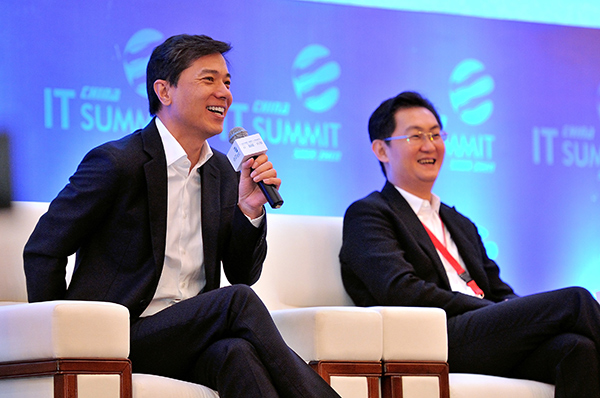 |
|
Robin Li, chief executive officer of Baidu Inc, speaks while Tencent's CEO Pony Ma listens during arecent IT summit in Shenzhen, Guangdong province.
|
Forget Beijing and Shanghai. China's economic future is emerging in Shenzhen.
Once a collection of fishing enclaves next door to Hong Kong, Shenzhen has become theepicenter of China's manufacturing-driven miracle. It is staking its future growth on finance,technology and culture.
The metropolis teeming with millions of migrant workers is home to some of China's biggestand hottest companies. Many are led by a new wave of young Chinese entrepreneurs hopingto build global brand recognition.
Divided from Hong Kong by a river, Shenzhen has been the preferred laboratory forexperiments by China's leaders since reformist Deng Xiaoping designated the tranquil area asthe country's first "special economic zone" in 1979.
Now a sprawling megacity of 11 million people, its fortunes were made churning out cheapclothes, electronics and toys for big foreign brands. But low cost manufacturers like Applesupplier Foxconn have been moving inland or out of China as labor costs increased. Now thefocus is on higher value-added, homegrown technology.
Innovative new companies are drawn by Shenzhen's well-established manufacturing supplychains and transport links, proximity to Hong Kong's banking and financial expertise, andbetter traffic, milder weather and less air pollution than Beijing and Shanghai.
"Shenzhen is becoming the new frontier for technology because it has the infrastructure forwhoever wants to turn their ideas into products," said Eric Pan, founder of Seeed Technology,a contract manufacturer for "makers" - tinkerers, hackers and inventors.
Pan quit a job at Intel in Beijing and moved to Shenzhen seven years ago. He helped fosterthe city's "maker faire" movement, festivals that celebrate arts, crafts, engineering and open-source technology that have been spreading around the world over the past decade.Shenzhen's event last year drew 190,000 people.
"People rush over to Shenzhen. They are young, they are reckless and they shape the city. Ithink that's the fundamental difference from other cities in China," Pan said.
Established tech giants such as telecom gear makers Huawei and ZTE and internet companyTencent call Shenzhen home. So do rising stars like DJI Technology Co., the world's No. 1supplier of civilian drones, inspiring local rivals such as Xenosky and Flypro. BGI, the world'sbiggest gene research center, and Kuangchi Science, the main investor in New Zealandjetpack maker Martin Aircraft, are also based here.
Emerging industries such as information technology, biotech, green energy and new materialsnow account for about 40 percent of Shenzhen's economic output, Mayor Xu Qin said lastmonth, according to State media. He gave no specific figures.
"For us, everything is made here in Shenzhen or in the surrounding areas. All your suppliersare here, all your spare parts are here. It just made natural sense to start here," said Carl Pei,the 26-year-old co-founder of Android smartphone maker OnePlus. The three-year-oldcompany scored a surprise hit with its first device, the OnePlus One, selling more than 1million units in a marketing campaign that relied on social media buzz.
At OnePlus, the vibe is definitely more Silicon Valley than southern China, as staff glidearound on skateboards and tend to the office dog. The company gets 80 percent of its sales,all online, outside of China and is expanding in Europe, India and the United States.
Shenzhen's economy expanded at an 8.9 percent pace last year, while nationwide growthslowed to a 25-year low of 6.9 percent. Per capita GDP has risen to 158,000 yuan ($24,334),on a par with Portugal. Meanwhile, growth in Hong Kong slowed to 2.4 percent.
Christopher Balding, an economics professor at Peking University's Shenzhen-basedgraduate HSBC School of Business, says Shenzhen's business environment is more open tohardworking newcomers than those of other Chinese cities where state-owned industriesdominate and vested interests mean that success often depends more on governmentconnections, or "guanxi."
"Competition is one of the things that really sets Shenzhen apart," Balding said. If China'sleaders can replicate Shenzhen's innovation and competition-focused economic modelnationwide, it would indirectly have an "enormous impact" on the world economy, he said.
"It's a relatively safe bet that in 10 years the tech sector in Shenzhen will be continuing togrow and thrive and kind of be the Chinese Silicon Valley," Balding said.
During a visit early last year, Premier Li Keqiang stopped in at China's first virtual bank andchecked out a "maker space" for hobbyist inventors and entrepreneurs tinkering onprototypes, seeking to promote businesses relying on finance and innovation that Beijing isnurturing as the State-dominated economy matures.
Hoping to woo and nurture top talent, the city government earmarked 4.4 billion yuan ($676million) to hire foreign experts such as scientists and academics to facilitate innovation andentrepreneurship.
The challenge is in how to refashion the city as a modern, desirable place to live and work,the kind of place highly educated, well-paid white collar workers, including those fromoverseas, will want to call home.
Shenzhen shares many of the same trappings of growing wealth seen in other big Chinesecities, including Shanghai and Hong Kong. Its 599-meter (1,965-foot) Ping An InternationalFinance Center is the world's fourth-tallest, and China's second-tallest, skyscraper. Britain'sVictoria and Albert Museum is collaborating with State-owned China Merchants Group on adesign museum set to open next year.
